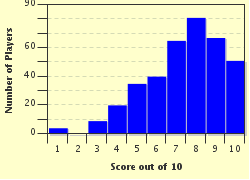Quiz Answer Key and Fun Facts
1. A frequent visitor to Gertrude Stein's salon was up-and-coming young author, Ernest Hemingway. One of his collections of stories was about a young autobiographical character, Nick Adams. One of the best known stories from this collection was "Big Two-Hearted _____________". Big Two-Hearted what?
2. F. Scott Fitzgerald also was a visitor to Stein's salon. One of his greatest novels was "The Great Gatsby". The novel reveals Fitzgerald's view of the attitude of the idle rich toward those of what they considered a lower class.
What was the view of the rich?
3. Many authors were not in Stein's "charmed circle", and one of these was Stephen Crane. His most famous work is a war novel, "The Red Badge of Courage". In what war is that novel set?
4. Nathaniel Hawthorne used Puritan New England for his setting in many of his works, including his most famous novel, "The Scarlet Letter". What Puritan city was the setting for this story of sin and repentence?
5. Many American authors have seen nature as an inspiration and subject for their poetry. Joyce Kilmer wrote probably the most famous and popular poem about something in nature. What nature poem did he write?
6. Emily Dickinson is thought of as one of America's important poets. She wrote of illness, death and immortality, among other themes. Her life spanned the mid-1800s. Which answer below does not describe her writing?
7. "The Murders in the Rue Morgue", a story by Edgar Allan Poe in 1841, introduces a man with brilliant powers of observation and deduction. These attributes of the man, Dupin, lead us to follow him through a story that is known as what?
8. In 1960, John Steinbeck took an extensive trip around the United States, and wrote a book about it. He took along his friend and the result was one of the most readable travel books, ever.
What was the name of this book?
9. Upton Sinclair wrote an important novel in 1906, "The Jungle". A novel set in a certain U.S. industry, it exposed conditions so bad that the book led to reform. What was the industry?
10. Here we are, back to Gertrude Stein. She was considered a Modernist poet. Some of her poems reminded critics of Cubism, an art form co-invented by Pablo Picasso, another favorite at her salon. Some of her works are known for short, cryptic lines. What flower was one of these about?
Source: Author
mpkitty
This quiz was reviewed by FunTrivia editor
looney_tunes before going online.
Any errors found in FunTrivia content are routinely corrected through our feedback system.


